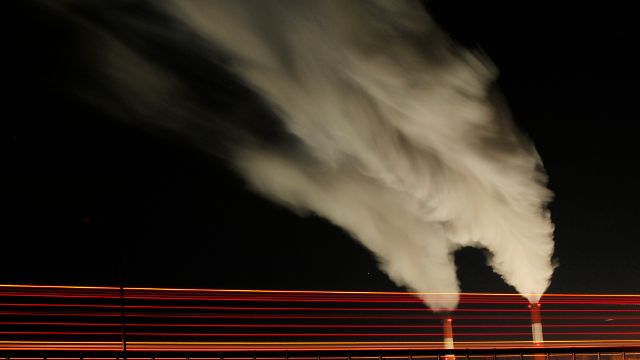
The Supreme Court is hearing two major challenges to the Environmental Protection Agency’s (EPA) authority to regulate greenhouse gas emissions. Last week, Thomas Donnelly, counsel to the Constitutional Accountability Center, wrote a post titled, “Six Reasons the Greenhouse Gas Cases Are Worth Watching,” which detailed the background of the cases and outlined the political landscape that brought them before the court.
The first case was argued in December. EPA v. EME Homer was a challenge to the EPA’s ability to regulate pollution that drifts across state lines. Arguments in the second case, Utility Air Regulatory Group v. EPA, began yesterday.
BillMoyers.com asked Donnelly to bring us up to speed on these potentially significant cases. Below is a transcript of our conversation that’s been lightly edited for clarity.
Joshua Holland: Let’s begin with the basics. Can you give us a little bit of the background of this week’s case?
Thomas Donnelly: Absolutely. Utility Air Regulatory Group v. EPA is a follow-up case to one of the landmarks of the last decade in the Roberts court, called Massachusetts v. EPA. And that green-lighted EPA’s efforts to regulate climate change. It said that under the Clean Air Act, greenhouse gases are covered and that EPA must go forward and figure out whether or not there’s a genuine threat there, and if there is, must address it by valid regulations.
This case now is a follow-up to that, weighing whether or not EPA can now extend regulations to what are called stationary sources. These are power plants, large emitters of greenhouse gas emissions. And industry challengers, along with some states, like Texas, have come into court and said, “EPA, you cannot do this. You’re overstepping your bounds.” And EPA’s coming back and saying, “Well, the court said seven years ago, in a very important decision, that we have the authority to address greenhouse gases and the threat of climate change, and so we’re doing it here, and we’re doing it in a way that is consistent with the last five presidential administrations in terms of how they’ve interpreted this important provision of the Clean Air Act.”
Holland: It seemed like this had been somewhat settled law. Were you surprised that the Supreme Court took these challenges up?
Donnelly: Well, just backing up slightly, one of the most important things about this case is what the Court decided not to take. It doesn’t surprise me that the US Chamber of Commerce, other industry groups and states with conservative attorneys general would come to court and try to stifle anything EPA wants to do to address climate change.
In their petitions to the Court here, they took a very aggressive stance, asking the Court to reconsider Massachusetts v. EPA, challenging other greenhouse gas regulations and finally challenging this other move that EPA made to address stationary sources.
And the Court effectively threw out the petitions as to those broader questions and really fixed on this particular program. So the decision by this Court to not grant those other petitions confirms the Obama administration and future administrations’ power to deal with climate change under the Clean Air Act. So in an important sense, that law really is settled and there’s no going back.
They are challenging an important program, but if the Court sticks to the issues it actually granted in this case, then even if EPA loses, it will still have other tools to address climate change.
Holland: Do the Court’s evidentiary rules preclude having any arguments over the science of climate change itself?
Donnelly: What EPA did after Massachusetts v. EPA was go and review the science, and it determined that greenhouse gases do endanger the public health of Americans. That was through an extensive regulatory process, where there were thousands upon thousands of comments, and they reviewed all the evidence and said, “Yes, there’s a threat. Now we have to address it.”
The industry groups here did ask the Court to review that determination, but the Court decided not to review that particular question. So while the Court certainly could’ve done that, it chose not to, and so if the Court sticks to the issues it actually granted, we will not be jostling over those sorts of questions on Monday.
Holland: In the piece, you write that Washington’s highly polarized environment is one of the reasons that this question ended up before the Court. Can you explain that?
Donnelly: The Clean Air Act is a decades-old law. It used to be the case that bipartisan majorities would come together every few years and amend the act in important ways. But because of polarization in Congress, the Clean Air Act has not been amended since 1990. And what ends up happening is you have a very broadly worded statute that gives EPA a great deal of authority. It was actually constructed in that way to ensure that EPA can continue acting even if there is congressional gridlock. If there’s a new environmental threat, and science confirms it, then EPA can go out and address it without further congressional action.
But over time, as we do not update these laws, the president continues to act under that old authority to address new problems, and that opens up at least an opportunity for conservative groups — industry groups, in the case of climate change — to come in and say, “No, no, the president is addressing a problem that Congress didn’t think about in 1990. No matter what the text of the statute says, Congress didn’t really intend that.”
And so you end up having ongoing litigation addressing what the administration’s doing, and it ultimately ends up before the Supreme Court. The Supreme Court as it exists now — the Roberts Court — is a very conservative Supreme Court, and they end up getting to decide these questions.
Holland: Barack Obama is on pace to issue the fewest executive orders since Grover Cleveland in the late 1800s. But that hasn’t prevented conservatives from adopting this narrative that he’s some kind of tyrant operating above the law, issuing executive orders left and right. How is that playing out in these cases?
Donnelly: Both the industry challengers, and a lot of the groups filing “friend of the court” briefs on their behalf — important people like Mitch McConnell, Rand Paul filed amicus briefs in this case in support of the industry groups — are making exactly that claim, which is that EPA is exceeding its authority and essentially rewriting the law.
What this ends up ignoring is that, again, the Clean Air Act was written quite broadly with the idea that EPA would be able to address new threats over time without having to go back to Congress. Furthermore, what the Obama Administration is doing here is following a reading of the statute that’s over three decades old. It’s not as though they just took this statutory provision and said, “Oh, we really want to do something on climate change and we’re going to invent a new interpretation to allow us to do that.” They’re following the same interpretation of previous administrations, Republicans and Democrats alike, except this time it actually leads to actions on climate change.
So there’s certainly an attempt from the other side to make this sound like it’s an absolutely radical, crazy move by the Obama Administration, but in fact, it’s very much in line with past executive practice.
Holland: You mentioned that the Chamber of Commerce is one of a bunch of parties suing the EPA in this case. Tell us about the Chamber’s role.
Donnelly: On behalf of their own membership, they often go into the DC circuit, which is an appeals court that’s very important when it comes to environmental regulations and challenge regulations like this. What makes this notable is the overall success of the US Chamber of Commerce before the Roberts Court, where it’s wining over 70 percent of its cases; since the beginning of October term 2011, it’s won about 90 percent of its cases.
Holland: In the piece you write, “The petitioners don’t agree on what the statute actually requires, or how far the Court should go to check the ‘lawless Obama Administration.’” Can you unpack that for us?
Donnelly: Absolutely. This case consolidates six different challenges. That’s not unusual when it comes to regulatory cases like this, but at the beginning of the briefing in a case like this, it’s common for petitioners to come together around one argument, or maybe even two arguments, and file a consolidated brief. But in this case, we had seven different briefs by the petitioners, giving the Court a variety of options how to rule, some quite broad, some narrow. But in the end, all that they could agree upon was that they really didn’t like what the EPA did and thought that it was wrong. They weren’t able to come around to one particular position.
Holland: So here the Court has a Chinese menu of possible resolutions.
It’s a sign of how far to the right the Court has drifted that Anthony Kennedy, who was appointed by Ronald Reagan, is the so-called moderate swing vote. What can we expect from him in these cases?
Donnelly: It’s always tough to predict. The one thing to understand about his role, particularly when it comes to climate change, is that we think of Justice Kennedy in terms of his opinion last term on marriage equality in Windsor, or gay rights in Lawrence v. Texas a few terms ago, and his push for equality when it comes to sexual orientation is an important part of his legacy. But if we want to understand the fullness of his legacy, one of the most important things that Justice Kennedy did was join with the four progressive justices in Massachusetts v. EPA seven years ago. It was that particular decision, in the face of foot-dragging by the Bush administration, that really cleared the way for the actions that you see the Obama administration taking on climate change, including their moves in the case that’s being challenged this week. All eyes will be on Justice Kennedy, and it’s certainly the case that he has played a very constructive role when it comes to the authority of EPA to address climate change.
Holland: Tom, when can we expect a ruling in these cases?
Donnelly: Given how late it is in the term, we’re not going to see a decision until near the end of the term, so in late June.


